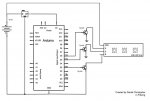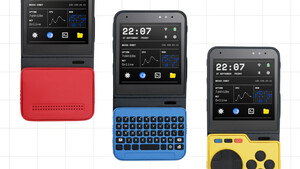// Arduino "bridge" code between host computer and WS2801-based digital
// RGB LED pixels (e.g. Adafruit product ID #322). Intended for use
// with USB-native boards such as Teensy or Adafruit 32u4 Breakout;
// works on normal serial Arduinos, but throughput is severely limited.
// LED data is streamed, not buffered, making this suitable for larger
// installations (e.g. video wall, etc.) than could otherwise be held
// in the Arduino's limited RAM.
// Some effort is put into avoiding buffer underruns (where the output
// side becomes starved of data). The WS2801 latch protocol, being
// delay-based, could be inadvertently triggered if the USB bus or CPU
// is swamped with other tasks. This code buffers incoming serial data
// and introduces intentional pauses if there's a threat of the buffer
// draining prematurely. The cost of this complexity is somewhat
// reduced throughput, the gain is that most visual glitches are
// avoided (though ultimately a function of the load on the USB bus and
// host CPU, and out of our control).
// LED data and clock lines are connected to the Arduino's SPI output.
// On traditional Arduino boards, SPI data out is digital pin 11 and
// clock is digital pin 13. On both Teensy and the 32u4 Breakout,
// data out is pin B2, clock is B1. LEDs should be externally
// powered -- trying to run any more than just a few off the Arduino's
// 5V line is generally a Bad Idea. LED ground should also be
// connected to Arduino ground.
// --------------------------------------------------------------------
// This file is part of Adalight.
// Adalight is free software: you can redistribute it and/or modify
// it under the terms of the GNU Lesser General Public License as
// published by the Free Software Foundation, either version 3 of
// the License, or (at your option) any later version.
// Adalight is distributed in the hope that it will be useful,
// but WITHOUT ANY WARRANTY; without even the implied warranty of
// MERCHANTABILITY or FITNESS FOR A PARTICULAR PURPOSE. See the
// GNU Lesser General Public License for more details.
// You should have received a copy of the GNU Lesser General Public
// License along with Adalight. If not, see
// <http://www.gnu.org/licenses/>.
// --------------------------------------------------------------------
#include <SPI.h>
// LED pin for Adafruit 32u4 Breakout Board:
//#define LED_DDR DDRE
//#define LED_PORT PORTE
//#define LED_PIN _BV(PORTE6)
// LED pin for Teensy:
//#define LED_DDR DDRD
//#define LED_PORT PORTD
//#define LED_PIN _BV(PORTD6)
// LED pin for Arduino:
#define LED_DDR DDRB
#define LED_PORT PORTB
#define LED_PIN _BV(PORTB5)
// A 'magic word' (along with LED count & checksum) precedes each block
// of LED data; this assists the microcontroller in syncing up with the
// host-side software and properly issuing the latch (host I/O is
// likely buffered, making usleep() unreliable for latch). You may see
// an initial glitchy frame or two until the two come into alignment.
// The magic word can be whatever sequence you like, but each character
// should be unique, and frequent pixel values like 0 and 255 are
// avoided -- fewer false positives. The host software will need to
// generate a compatible header: immediately following the magic word
// are three bytes: a 16-bit count of the number of LEDs (high byte
// first) followed by a simple checksum value (high byte XOR low byte
// XOR 0x55). LED data follows, 3 bytes per LED, in order R, G, B,
// where 0 = off and 255 = max brightness.
static const uint8_t magic[] = {'A','d','a'};
#define MAGICSIZE sizeof(magic)
#define HEADERSIZE (MAGICSIZE + 3)
#define MODE_HEADER 0
#define MODE_HOLD 1
#define MODE_DATA 2
// If no serial data is received for a while, the LEDs are shut off
// automatically. This avoids the annoying "stuck pixel" look when
// quitting LED display programs on the host computer.
static const unsigned long serialTimeout = 15000; // 15 seconds
void setup()
{
// Dirty trick: the circular buffer for serial data is 256 bytes,
// and the "in" and "out" indices are unsigned 8-bit types -- this
// much simplifies the cases where in/out need to "wrap around" the
// beginning/end of the buffer. Otherwise there'd be a ton of bit-
// masking and/or conditional code every time one of these indices
// needs to change, slowing things down tremendously.
uint8_t
buffer[256],
indexIn = 0,
indexOut = 0,
mode = MODE_HEADER,
hi, lo, chk, i, spiFlag;
int16_t
bytesBuffered = 0,
hold = 0,
c;
int32_t
bytesRemaining;
unsigned long
startTime,
lastByteTime,
lastAckTime,
t;
LED_DDR |= LED_PIN; // Enable output for LED
LED_PORT &= ~LED_PIN; // LED off
Serial.begin(115200); // Teensy/32u4 disregards baud rate; is OK!
SPI.begin();
SPI.setBitOrder(MSBFIRST);
SPI.setDataMode(SPI_MODE0);
SPI.setClockDivider(SPI_CLOCK_DIV16); // 1 MHz max, else flicker
// Issue test pattern to LEDs on startup. This helps verify that
// wiring between the Arduino and LEDs is correct. Not knowing the
// actual number of LEDs connected, this sets all of them (well, up
// to the first 25,000, so as not to be TOO time consuming) to red,
// green, blue, then off. Once you're confident everything is working
// end-to-end, it's OK to comment this out and reprogram the Arduino.
uint8_t testcolor[] = { 0, 0, 0, 255, 0, 0 };
for(char n=3; n>=0; n--) {
for(c=0; c<25000; c++) {
for(i=0; i<3; i++) {
for(SPDR = testcolor[n + i]; !(SPSR & _BV(SPIF)); );
}
}
delay(1); // One millisecond pause = latch
}
Serial.print("Ada\n"); // Send ACK string to host
startTime = micros();
lastByteTime = lastAckTime = millis();
// loop() is avoided as even that small bit of function overhead
// has a measurable impact on this code's overall throughput.
for(;;) {
// Implementation is a simple finite-state machine.
// Regardless of mode, check for serial input each time:
t = millis();
if((bytesBuffered < 256) && ((c = Serial.read()) >= 0)) {
buffer[indexIn++] = c;
bytesBuffered++;
lastByteTime = lastAckTime = t; // Reset timeout counters
} else {
// No data received. If this persists, send an ACK packet
// to host once every second to alert it to our presence.
if((t - lastAckTime) > 1000) {
Serial.print("Ada\n"); // Send ACK string to host
lastAckTime = t; // Reset counter
}
// If no data received for an extended time, turn off all LEDs.
if((t - lastByteTime) > serialTimeout) {
for(c=0; c<32767; c++) {
for(SPDR=0; !(SPSR & _BV(SPIF)); );
}
delay(1); // One millisecond pause = latch
lastByteTime = t; // Reset counter
}
}
switch(mode) {
case MODE_HEADER:
// In header-seeking mode. Is there enough data to check?
if(bytesBuffered >= HEADERSIZE) {
// Indeed. Check for a 'magic word' match.
for(i=0; (i<MAGICSIZE) && (buffer[indexOut++] == magic[i++]););
if(i == MAGICSIZE) {
// Magic word matches. Now how about the checksum?
hi = buffer[indexOut++];
lo = buffer[indexOut++];
chk = buffer[indexOut++];
if(chk == (hi ^ lo ^ 0x55)) {
// Checksum looks valid. Get 16-bit LED count, add 1
// (# LEDs is always > 0) and multiply by 3 for R,G,B.
bytesRemaining = 3L * (256L * (long)hi + (long)lo + 1L);
bytesBuffered -= 3;
spiFlag = 0; // No data out yet
mode = MODE_HOLD; // Proceed to latch wait mode
} else {
// Checksum didn't match; search resumes after magic word.
indexOut -= 3; // Rewind
}
} // else no header match. Resume at first mismatched byte.
bytesBuffered -= i;
}
break;
case MODE_HOLD:
// Ostensibly "waiting for the latch from the prior frame
// to complete" mode, but may also revert to this mode when
// underrun prevention necessitates a delay.
if((micros() - startTime) < hold) break; // Still holding; keep buffering
// Latch/delay complete. Advance to data-issuing mode...
LED_PORT &= ~LED_PIN; // LED off
mode = MODE_DATA; // ...and fall through (no break):
case MODE_DATA:
while(spiFlag && !(SPSR & _BV(SPIF))); // Wait for prior byte
if(bytesRemaining > 0) {
if(bytesBuffered > 0) {
SPDR = buffer[indexOut++]; // Issue next byte
bytesBuffered--;
bytesRemaining--;
spiFlag = 1;
}
// If serial buffer is threatening to underrun, start
// introducing progressively longer pauses to allow more
// data to arrive (up to a point).
if((bytesBuffered < 32) && (bytesRemaining > bytesBuffered)) {
startTime = micros();
hold = 100 + (32 - bytesBuffered) * 10;
mode = MODE_HOLD;
}
} else {
// End of data -- issue latch:
startTime = micros();
hold = 1000; // Latch duration = 1000 uS
LED_PORT |= LED_PIN; // LED on
mode = MODE_HEADER; // Begin next header search
}
} // end switch
} // end for(;;)
}
void loop()
{
// Not used. See note in setup() function.
}




